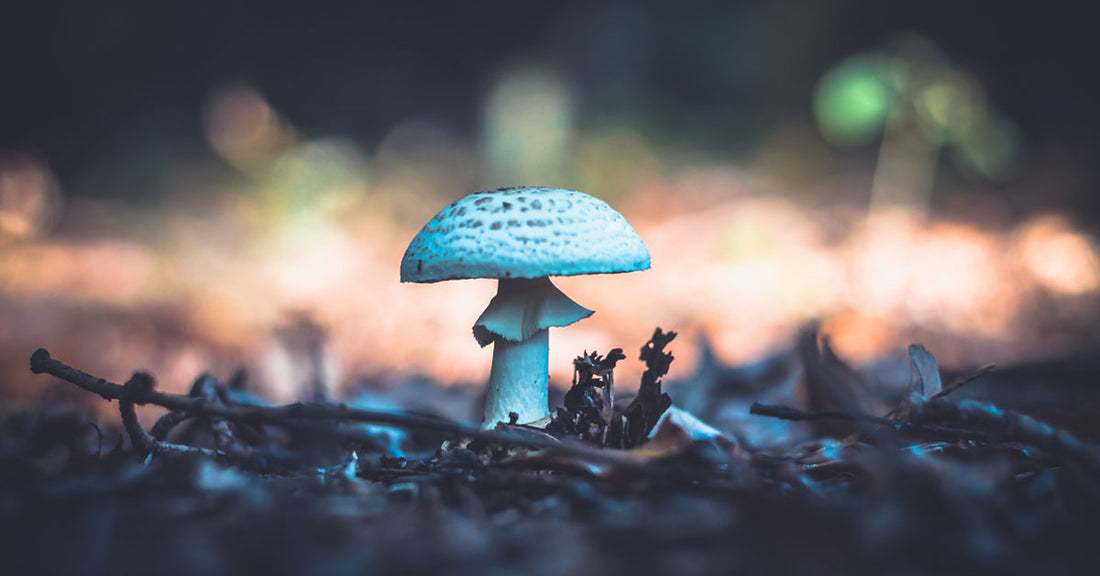Anyone in a successful long-term relationship knows that the key to a harmonious, even symbiotic, existence is clear and regular communication.
And nowhere is that more apparent than in the world of fungi.
According to recent research, various species of fungi use patterns of electrical pulses to communicate their desires across their reticulated mycelial networks, like thoughts traveling in a human mind.
However similar in the medium of their self-talk, the communal hive mind of a fungus has a wholly different flavor of internal dialogue than the egocentric human brain, according to William Padilla-Brown, a citizen scientist and founder of MycoSymbiotics.
“Fungi operate in a realm of pure economic communication that is based in the greater good,” says Padilla-Brown, who is also MUD\WTR’s mycology advisor.
He points out that when observing fungal cells under a microscope, as they find and consume water or food, one can witness the thoughtful organism’s mutual aid in action.
“I like to see the tips of the fungal network like individual people,” he says. “One is like, ‘hey, I found some water, or I got some nitrogen over here, or hey, a nematode!’ Not only does everyone in the network share their information, they also distribute the water and the nitrogen and the nutrients equally with each other.”
Scientists like Padilla-Brown have indirectly interpreted the organism’s intentions by observing fungi’s egalitarian behavior, but the actual mechanism of the mycelium’s self-talk was up for wider speculation until April 2022. That’s when Adam Adamatzky, a professor at the University of the West of England, published a study on the subject.
By sticking electrodes into mycelial networks, Adamatzky observed that the fungi responded to physical and chemical stimuli with varying strengths of electrical impulses. He then measured the strength and patterns of the voltage spikes, and discovered an order in the chaos. The amplitude changes were similar in structure to electrical impulses in an animal’s brain, called action potentials, which travel away from neurons across structures that form a network like mycelium.
Adamatzky realized that the patterns of the electrical spikes also mirrored word structures in European languages. With that in mind, he parsed out about 50 different word-like messages within the amplitude changes in the fungi’s electrical voltage spikes by converting them into binary units. Among the 50 or so “words” used by the four fungal species Adamatzky studied, he noticed that 15 to 20 were used more frequently.
“That’s just the physical side of the communication, but the consciousness of fungi goes way deeper,” says Fungi Academy’s Hyphae Headmaster, Jasper Degenaars. “They have a deep understanding of what makes the natural environment thrive and they support everything around them.”
In 2021, a study by professor Nicholas P. Money (yes, that’s his real name) from Miami University in Oxford, Ohio, gave scientific evidence that fungal mycelia consciously react to their environment and other creatures, and have spatial reasoning and even short-term memory. Degenaars, who instructs courses on mushroom biology and cultivation at Fungi Academy in Guatemala—and isn’t bound by the constraints of formal academia—goes further.
“They are definitely conscious and definitely intelligent,” he says. “They are just on a whole different dimension than we are.”
He points to fungi’s almost supernatural ability to intentionally synthesize chemical compounds to better consume different types of food, protect itself from predators and communicate with other species, like us, with a long-term plan seemingly in mind.
“I see fungi as the ultimate alchemist of the natural world,” says Degenaars. “They are able to create all these complex chemicals and alkaloids on a whim and then store the information from the outcome in the data banks of its DNA.”
To truly understand the consciousness of mushrooms, Padilla-Brown looks back at the prehistoric past. Fungi have been evolving on Earth for more than a billion years, and were the dominant species on the planet millions of years ago. As fungi thrive in the water and on land, inside and alongside plants and animals, and synthesize chemical compounds for their own designs, Padilla-Brown sees fungi as the ancient intelligent designers of Earth’s ecosystem.
“We know that when a pathogen threatens a mushroom or its symbiote, fungi will create an antibiotic to get rid of the pathogen,” he says. “We also know that they farm yeasts and microbes for themselves, and if you take that understanding back hundreds of millions of years, you can understand that as life was first evolving, fungi were choosing the single-cell organisms that got to stick around. So when we look at the forests today, they are composed mostly of fungal decisions.”
Having scientifically shown that fungi are conscious, intelligent and creative, and having discovered the physical mechanism for their communication, the implications for new technology are only limited by our own relatively small neuronal networks. With the potential for his research in mind, Adamatzky has published studies on fungal electronics, which could harness the sensory capabilities of mycelium in wearable technologies, and fungal architecture, where a house would be grown instead of built.
Aside from the practical applications that could be born from translating and communicating with fungi, Degenaars is also excited for the philosophical implications that could come with interspecies communication, which fungi seem to have down to a science.
“For example, look at the Humongous Fungus in Oregon, the most massive organism in the world, which has arguably lived for hundreds or thousands of years,” says Degenaars. “If we learned to communicate with it, what secrets would this organism have? What could we learn from it? If it does happen, I believe it will give us more empathy for nature and for each other.”
Communicating with fungi will take some out-of-this-world thinking and plenty of listening and rumination, according to Padilla-Brown. He explains that when humans typically think about extraterrestrials, they imagine them with humanoid forms and think that they will experience the world and travel in space in a human way. But we actually have no idea.
Whether extraterrestrial life forms will walk and talk like us remains to be seen, but we do know that fungi communication is similar yet very different from humanity’s symbolic, verbal discourse. So before we can open a dialogue, we’ll have to get on their level.
“Right now humans have a hard time putting themselves in another person’s shoes, let alone another organism’s shoes,” says Padilla-Brown. “But I do believe in the future we’ll be able to wire our computers directly into the forest through the mycelium, and see all the connections, and hear some very powerful messages.”
Aric Sleeper is an independent journalist covering labor, drug reform, food and the arts.
Header image by Erik-Jan Leusink via Unsplash.
Read more: Following Her Gut
Read more: WTF is Astromycology?
Read more: How Gut Health Affects Mental Health




